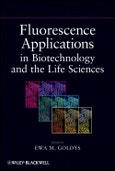This book focuses specifically on the present applications of fluorescence in molecular and cellular dynamics, biological/medical imaging, proteomics, genomics, and flow cytometry. It raises awareness of the latest scientific approaches and technologies that may help resolve problems relevant for the industry and the community in areas such as public health, food safety, and environmental monitoring.
Following an introductory chapter on the basics of fluorescence, the book covers: labeling of cells with fluorescent dyes; genetically encoded fluorescent proteins; nanoparticle fluorescence probes; quantitative analysis of fluorescent images; spectral imaging and unmixing; correlation of light with electron microscopy; fluorescence resonance energy transfer and applications; monitoring molecular dynamics in live cells using fluorescence photo-bleaching; time-resolved fluorescence in microscopy; fluorescence correlation spectroscopy; flow cytometry; fluorescence in diagnostic imaging; fluorescence in clinical diagnoses; immunochemical detection of analytes by using fluorescence; membrane organization; and probing the kinetics of ion pumps via voltage-sensitive fluorescent dyes.
With its multidisciplinary approach and excellent balance of research and diagnostic topics, this book is an essential resource for postgraduate students and a broad range of scientists and researchers in biology, physics, chemistry, biotechnology, bioengineering, and medicine.
Table of Contents
Preface.Acknowledgments.
About the Contributing Authors.
1 Basics of Fluorescence (Robert P. Learmonth, Scott H. Kable, and Kenneth P. Ghiggino).
1.1 Introduction.
1.2 Absorption and Emission of Light.
1.3 Nonradiative Decay Mechanisms.
1.4 Properties of Excited Molecules.
1.5 Spectroscopy and Fluorophores.
1.6 Environmental Sensitivity of Fluorophores.
1.7 Polarization of Fluorescence.
1.8 Conclusion.
References.
2 Labeling of Cells with Fluorescent Dyes (Ian S. Harper).
2.1 Introduction.
2.2 Fluorophore Selection.
2.3 Loading and Labeling Live Cells.
2.4 Fluorophores for Live Cell Imaging.
References.
3 Genetically Encoded Fluorescent Probes: Some Properties and Applications in Life Sciences (Mark Prescott and Anya Salih).
3.1 Introduction.
3.2 Chromophore and its Formation.
3.3 “Life and Death” of Fluorescent Protein.
3.4 Applications.
3.5 Passive Applications.
3.6 Active Applications.
3.7 Interactive Applications.
3.8 Conclusions.
References.
4 Nanoparticle Fluorescence Probes (Krystyna Drozdowicz-Tomsia and Ewa M. Goldys).
4.1 Introduction.
4.2 Nanomaterials for Biological Applications.
4.3 Inorganic Quantum Dots: Physics and Optical Properties.
4.4 Synthesis of Monodisperse Colloidal Quantum Dots for Biolabeling Applications.
4.5 Quantum Dots as In Vitro Probes.
4.6 Quantum Dots as In Vivo Probes.
4.7 Cytotoxicity.
4.8 Future Directions.
References.
5 Quantitative Analysis of Fluorescent Image: From Descriptive to Computational Microscopy (Michal Marek Godlewski, Agnieszka Turowska, Paulina Jedynak, Daniel Martinez Puig, and Helena Nevalainen).
5.1 Introduction.
5.2 Advantages of Quantitative Analysis.
5.3 Methods of Quantitative Analysis.
5.4 Image Processing.
References.
6 Spectral Imaging and Unmixing (Pascal Vallotton, Aloke Phatak, and Mark Berman).
6.1 Introduction.
6.2 Instrumentation and Configurations for Hyperspectral Microscopes.
6.3 Supervised and Unsupervised Unmixing.
6.4 Supervised or Informed Unmixing.
6.5 Unsupervised or Blind Unmixing.
6.6 Spectral Clustering.
6.7 Examples.
6.8 Limitations of Spectral Imaging and Experimental Considerations.
6.9 Conclusions.
References.
7 Correlation of Light with Electron Microscopy: A Correlative Microscopy Platform (Marko Nykanen)
7.1 Introduction.
7.2 Overview of Techniques Used in Correlative Microscopy.
7.3 Correlative Microscopy of Chemically Fixed, Immunolabeled Ultrathin Cryosections Employing Antibodies Coupled with Fluorescent Gold Conjugates.
7.4 Special Techniques Used in Sample Preparation for Correlative Microscopy: High-Pressure Freezing, Freeze Fracturing, and Freeze Substitution.
7.5 Correlative Microscopy of Fixed Tissue Specimens Using Freeze Substitution.
7.6 Future Trends: Correlative Microscopy and High-Content Cellular Screening.
7.7 Future Trends: Correlative Microscopy of Fluorescent Images Acquired by Confocal Laser Scanning Microscopy.
References.
8 Fluorescence Resonance Energy Transfer and Applications (Andrew Clayton).
8.1 What is FRET?
8.2 Why FRET Can Be Useful.
8.3 How FRET Can Be Measured.
8.4 Emerging Applications Including Novel FRET Probes.
8.5 Advanced FRET Methods.
References.
9 Monitoring Molecular Dynamics in Live Cells Using Fluorescence Photobleaching (Nectarios Klonis and Leann Tilley).
9.1 Introduction.
9.2 Photobleaching Theory.
9.3 Dynamics of Macromolecules.
9.4 Photobleaching Measurements with Confocal Microscope.
9.5 Photobleaching Applications.
9.6 Conclusions.
References.
10 Time-Resolved Fluorescence in Microscopy (Trevor A. Smith, Craig N. Lincoln, and Damian K. Bird).
10.1 Introduction.
10.2 Photophysics and Deactivation of Excited State.
10.3 Time-Resolved Fluorescence Measurements.
10.4 Time-Resolved Fluorescence in Microscopy.
10.5 Conclusions.
References.
11 Fluorescence Correlation Spectroscopy (Thomas Dertinger, Iris von der Hocht, Anastasia Loman, Ingo Gregor, and J¨org Enderlein).
11.1 Introduction.
11.2 Optics of Fluorescence Correlation Spectroscopy.
11.3 Practical Aspects of FCS Experiments.
11.4 Quantitative Evaluation of FCS Measurements to Obtain Diffusion Constants and Concentration.
11.5 Conclusion.
References.
12 Flow Cytometry (Russell E. Connally, Graham Vesey, and Charlotte Morgan).
12.1 What is Flow Cytometry?
12.2 Excitation Sources.
12.3 Signal Detection and Analysis.
12.4 Cell Sorting.
12.5 Applications of Flow Cytometry.
References.
13 Fluorescence in Diagnostic Imaging (Morry Silberstein).
13.1 Introduction.
13.2 Principles of Fluorescence Applied to Medical Diagnosis.
13.3 Optical Fluorescence Imaging Techniques In Vivo.
13.4 Imaging of Whole-Body Biological Systems.
13.5 Future Directions.
References.
14 Fluorescence in Clinical Diagnosis (Wouter Kalle, Phillip Bwititi, and Todd Walker).
14.1 Introduction.
14.2 Applications of Fluorescence in Clinical Biochemistry.
14.3 Fluorescence in Pathology and Cancer Diagnostics.
References.
15 Immunochemical Detection of Analytes by Using Fluorescence(Evgenia G. Matveeva, Ignacy Gryczynski, Zygmunt Gryczynski, and Ewa M. Goldys).
15.1 Introduction: Definition and General Principles of Immunoassays.
15.2 Immunoassay Types and Formats.
15.3 Types of Analytes.
15.4 Steady-State Fluorescence Immunoassays.
15.5 Time-Resolved and Kinetic Approaches as Tools for Elimination of Fluorescence Background.
15.6 Recent Advances in Immunoassay Signal Enhancement and Throughput.
References.
16 Membrane Organization (Astrid Magenau, Carles Rentero, and Katharina Gaus).
16.1 Concepts of Organization of Biological Membranes.
16.2 Fluorescence Methods to Study Membrane Organization.
16.3 Model Membranes.
16.4 Membrane Organization in Cells.
References.
17 Probing Kinetics of Ion Pumps Via Voltage-Sensitive Fluorescent Dyes (Ronald J. Clarke).
17.1 Introduction: Voltage-Dependent Physiological Processes, Ion Pumps, and Channels.
17.2 Voltage-Sensitive Dyes: Mechanisms, Response Times, and Their Relevance for Kinetic Studies.
17.3 Steady-State Ion Pump Activity.
17.4 Kinetics of Ion Pump Partial Reactions.
17.5 Future Directions.
References.
Index.








